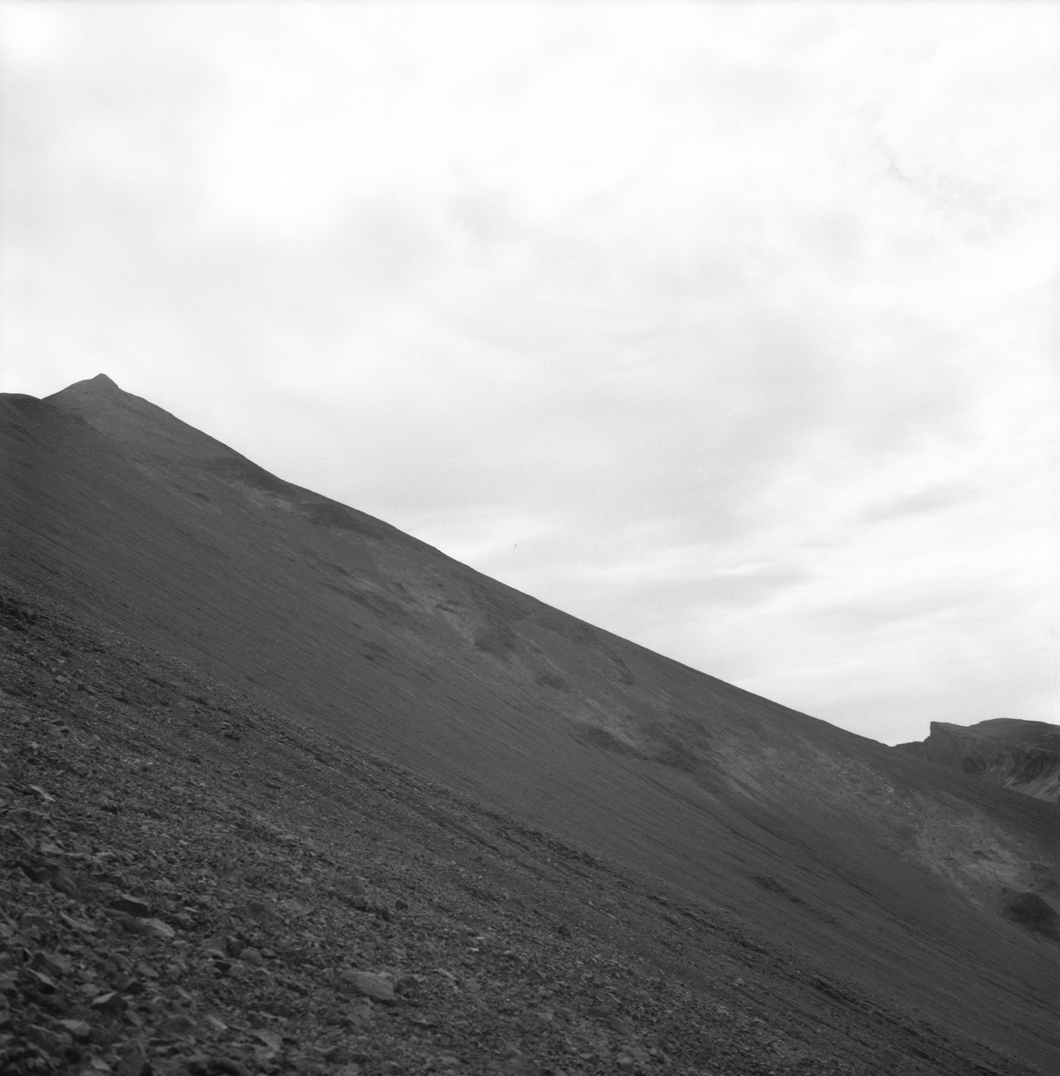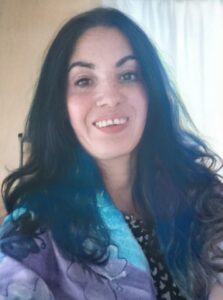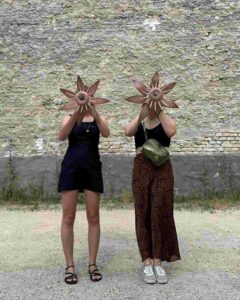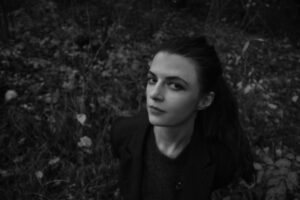Alena Kotzmannová
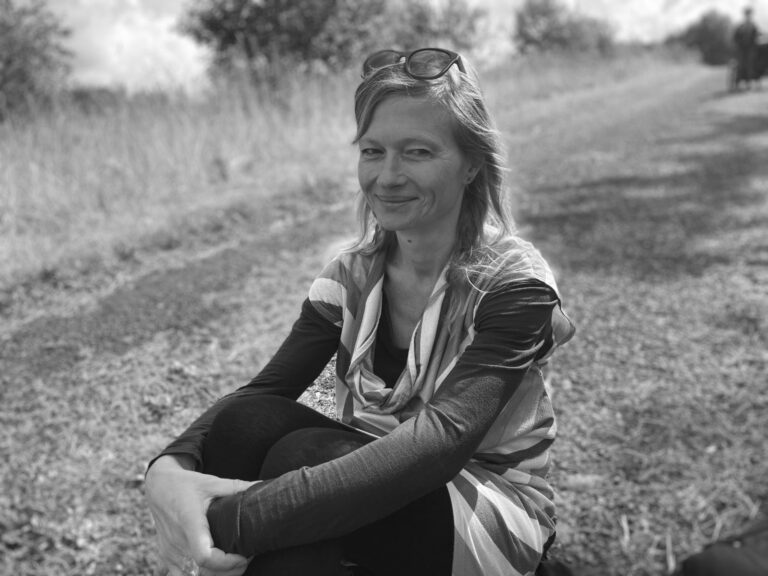
– born in 1974. She studied (1992-1998) at the Photography Atelier and at the Atelier of Conceptual and Intermedia Art of the Academy of Arts, Architecture and Design in Prague, and later obtained her Doctorate at the Charles University Pedagogical Faculty (2009-2014). She was twice a finalist of the Jindřich Chalupecký Award for young artists. In her work, she explores the possibilities and the essence of photographic media. Her own (primarily black and white) photographs are often combined with video projections or found objects.
Time and place don’t matter
Photography meets my inner need to express myself to the external world. In my opinion, its role is to create diversity. Artists can challenge people to perceive the world in a different way, and thanks to that, we are a society with ambitions larger than the provision of basic necessities – food and reproduction. However, sometimes it seems that the art scene forgets about the broader context, that is, a reasoning for why my work should actually be of interest to anyone. I consider it important, then, to ask the question Why? and to defend my work to the general public. I don’t intend for my artistic work to give concrete answers. I react to life, and life comprises questions both concrete and vague questions, perceptions and situations. I am mainly interested in those that are more difficult to comprehend and express.
From my initial studies of classical photography up to the present, in my work I address the transformation of photography as a medium, not only technically, but in the overall perception of its role in society – its storytelling value, ability to deceive, multiplicity and accessibility. I see its metamorphoses as the impulse to find new paths. For example, in an older series, Klasika (2001–2004), I focused on the credibility of the image and whether the mechanical eye of the camera can be made to capture the present as if in another historical period12. The Cyclone series (2004–2005), based on an indirect comparison of photographic pairs taken at different intervals from the same stand, pulls the viewer into a sense of uncertainty about the sequence of events and phenomena, as well as the very principle of photography. At the recent Silicones exhibition at the Fotograf Gallery in Prague (December 2020), I presented a multi-themed selection of photographs which were augmented by spilled silica sand.345 By adding physical material, I attempted to “decelerate the transience” of the moment, whose unique here-and-now quality has been a key element of this medium since its inception.
I have been building up my own private archive since about 1997. There are thousands of my own images and a number of interesting pieces that I didn’t photograph. For instance, the glass negatives of my great grandfather, who was a musician in the Austrian army and traveled the world’s seas and oceans on an army ship [My Cup of Sea, 2010–2011]6. I usually work in such a way that I use this archive to enhance the theme of a given project. I present the individual images in conjunction with others to contemporize them. It does not matter whether the photographs are one year old or ten years old, whether they were taken in Prague or Portugal … Working with a series of photographs also enables me to express myself on the theme from different angles, with more layers. But I have to have a reason to create a series instead of just one photo. I recently completed an extensive collection called An Attempt at Regaining Reality (2011–2019), which contains ten photographic series, including installations and video installations789. The point of departure for the motif of each of the Attempts is a found image or object, to which I join a larger number of photographs from different places and time periods. The series thereby functions as a presentation of rediscovered “evidence” which demonstrates that (based on the contextual transformation) the reality of the images is always represented differently and afresh.
I’m quite naturally interested in historical events or even apparently meaningless moments in which I find inspiration or timeless themes. I’m fascinated by visits to outer space, for instance. I like when a work of art succeeds in evoking a variety of associations. My aim is that the photograph or series should have a message that is “unspoken” and that the viewer’s perception makes up the rest of the story. My work Shopping is my Hobby offered up several interpretations10. It came about in 1998 in response to the boom in shopping center construction. The final rendition of this work in the public space was preceded by a series that I completed during my semester as a student in Norwich, UK. I had just left Prague for Norwich, and the head of the studio, professor Pavel Štecha, assigned the semestral theme of “Wenceslas Square.” I knew that I would not be able to take photos of Wenceslas Square, but I had to submit my work at the end of the term. So I made a small model of the statue of St. Wenceslas, the main monument on the square. On the streets of Norwich I performed a number of “silent performances” in which I lay on my belly or stood on a post to find the “most credible” images. At first glance, St. Wenceslas in the foreground evoked a Prague experience, but then the background revealed a strange, unreal context. I carried the model in a transparent plastic bag. In the end, the shot of the woman (my classmate) holding the bag seemed like a significant moment. With the addition of the message about shopping, the image evokes other possible interpretations in a broader socio-political or even feminist context.
At the end of the 1990s, when I appeared on the art scene, I didn’t feel any gender disadvantage. Perhaps it was the euphoria of the post revolutionary atmosphere, which was beautiful, but failed to see many systemic problems. Today, thanks to feminist activities, I feel a greater awareness in society as to the status of women. Similarly, with the new millennium, I see more local interest in women’s art. Obviously, the first step had to be taken by women, but it is clear now that the issues of feminism are not ignored by men. I see the future of feminist art as I do the future of every politician: if it is “fertile ground,” it will grow; if not, no one will need it. I do not distinguish between feminine and masculine art, but the duality of masculine and feminine principles seems natural to me. It generates a certain tension in the way we look at art or the world. I am proud of my womanhood and I consider having a family a gift; this feeling is stronger for me than the sense of a “career on hold.” Thanks to motherhood, I have also begun to look at some topics from a different perspective (e.g. The Last Footprint, 2018)1112. In addition, every work of art requires devoted time and concentration. I feel that having my own family has taught me to manage myself better in this arena.
This text was written in cooperation with Kristýna Péčová (2020).
1Image: Alena Kotzmannová, Klasika [Classic], 2001–2004, black and white photography. Courtesy of the artist.2Image: Alena Kotzmannová, Klasika [Classic], 2001–2004, black and white photography. Courtesy of the artist.
3Image: Alena Kotzmannová, Cyclone [Cyclone], 2004–2005, black and white photography. Courtesy of the artist.
4Image: Alena Kotzmannová, Cyclone [Cyclone], 2004–2005, black and white photography. Courtesy of the artist.
5See: www.fotografgallery.cz/alena-kotzmannova/.
6Image: Alena Kotzmannová, My Cup of Sea, 2010–2011, photography. Courtesy of the artist.
7Image: Alena Kotzmannová, An attempt at regaining reality, 2011–2019. Courtesy of the artist.
8Image: Alena Kotzmannová, An attempt at regaining reality, 2011–2019. Courtesy of the artist.
9A part of this collection was shown at the exhibit The Rabbit and the Queen at the Prague City Gallery. See: www.ghmp.cz/vystavy/alena-kotzmannova-kralik-a-kralovna/#pid=1.
10Image: Alena Kotzmannová, Shopping is my hobby, 1998, instalation. Courtesy of the artist.
11Image: Alena Kotzmannová,The Last Footprint, 2018, hand colored inkjet printing on Hahnemühle paper. Courtesy of the artist.
12Image: Alena Kotzmannová, The Last Footprint, 2018, black and white handmade magnification on baryta paper. Courtesy of the artist.
– narozena 1974, studovala v letech 1992 až 1998 na pražské Vysoké škole uměleckoprůmyslové v Ateliéru fotografie a v Ateliéru tvorby konceptuální a intermediální, později absolvovala doktorské studium na Pedagogické fakultě Univerzity Karlovy (2009-2014). Dvakrát se stala finalistkou Ceny Jindřicha Chalupeckého pro mladé umělce. Ve své tvorbě zkoumá možnosti i samotnou podstatu fotografického média a své (povětšinou černobílé) snímky často kombinuje s videoprojekcí nebo s nalezenými objekty.
Na čase a místě nezáleží
Umění se věnuji z vnitřní potřeby vyjadřovat se k vnějšímu světu. Jeho rolí je podle mě vytvářet pestrost. Umělci a umělkyně mohou formovat výzvy k jinému vnímání světa, díky nimž jsme společenstvím s ambicemi přesahujícími zajištění základních životních potřeb – jídla a rozmnožování. Někdy mi ale připadá, že se na umělecké scéně zapomíná na širší kontext, tedy dokázat vysvětlit, proč by vlastně měla moje práce někoho zajímat. Za důležité tak považuji nastolit otázku Proč? a obhájit si tvorbu také směrem k široké veřejnosti. Svou uměleckou praxí nezamýšlím dávat konkrétní odpovědi. Reaguji na život a ten se skládá z konkrétních i nekonkrétních otázek, vjemů a situací, přičemž mě zajímají hlavně ty hůře uchopitelné a vyslovitelné.
Od svých studií klasické fotografie po současnost se ve své tvorbě zabývám proměnou fotografie jako média nejen po technické stránce, ale i celkovým vnímáním její role ve společnosti – její vypovídací hodnotou, schopností klamat, multiplikovatelností a dosažitelností. Její přeměny chápu jako výzvu k hledání nových cest. Tak jsem se třeba ve své starší sérii Klasika (2001–2004)12 věnovala věrohodnosti záznamu a tomu, jestli je možné přimět mechanické oko fotoaparátu zachytit současnost pohledem jakoby z jiné historické doby. Také série Cyclone (2004–2005)34, založená na nepřímém porovnávání fotografických dvojic pořízených s různým časovým odstupem ze stejného stanoviště, uvádí diváka do nejistoty o souslednosti událostí a jevů, i o samotném principu focení. Aktuálně jsem na výstavě Silikony v pražské Fotograf Gallery (prosinec 2020) prezentovala v širším tematickém celku fotografie, jejichž detaily jsou doplněny vysypávaným křemičitým pískem5. Dodáním fyzického materiálu se snažím „zpomalit prchavost“ okamžiku, jehož jedinečnost teď a tady je klíčovým aspektem tohoto média od počátku jeho dějin.
Přibližně od roku 1997 si sestavuji soukromý archiv. Tvoří ho tisíce mých snímků, ale obsahuje i několik zajímavostí, které jsem nefotografovala já. Jsou v něm například skleněné negativy mého pradědečka, který byl hudebníkem u Rakouské armády a na vojenské lodi procestoval velkou část světových moří a oceánů [My Cup of Sea, 2010–2011]6. Většinou pracuji tak, že zvolené téma vykresluji sestavením souboru z tohoto archivu. Jednotlivé snímky předkládám v konjunkci s jinými jako vyjádření k něčemu aktuálnímu. Není pak důležité, jestli jsou fotografie staré rok nebo deset let, jestli jsou pořízené v Praze nebo třeba v Portugalsku… Práce ve fotografických sériích mi navíc umožňuje vyjádřit se k tématu z více úhlů pohledu, ve více vrstvách. K vytvoření série namísto jedné fotografie musím mít ale důvod. Nedávno jsem dokončila rozsáhlý soubor s názvem Pokus o znovunalezení skutečnosti (2011–2019)78, který obsahuje deset fotografických sérií, včetně instalací a videoinstalací9. Výchozím motivem každého z Pokusů je nalezený snímek či objekt, k němuž se vztahuji vždy větším počtem fotografií z různých míst a časových období. V tomto případě tak série vystupují jako prezentace znovunalezených „důkazů“, které na více příkladech prokazují, že (na základě proměny kontextu) je skutečnost obrazy reprezentována pokaždé jinak a nově.
Přirozeně se zajímám o historické události nebo i zdánlivě nevýznamné momenty, v nichž nacházím inspiraci a nadčasová témata. Fascinují mě například expedice do vesmíru. Líbí se mi, když dílo dokáže vyvolat různé asociace. Mým záměrem je, aby fotografie či série byly „nedořečené“ a jejich čtení zůstalo z části na divákovi. Dílo Shopping is my hobby10 nabízelo hned několik interpretací. Vzniklo v roce 1998 jako reakce na stavební boom obchodních center. Finální podobě této práce ve veřejném prostoru předcházela série, kterou jsem realizovala během studijního pobytu v britském Norwichi. Tehdy jsem odjížděla pouze na semestr a semestrální zadání od vedoucího ateliéru prof. Pavla Štechy bylo „Václavské náměstí“. Věděla jsem, že když odjedu, tak Václavák nenafotím, ale práci musím na konci semestru odevzdat. Vyrobila jsem si proto alespoň malý modýlek typické dominanty náměstí: sochy sv. Václava. V ulicích Norwiche jsem pak realizovala několik „tichých performancí“, kdy jsem si lehala na břicho nebo stoupala na patníky, abych našla co „nejvěrohodnější“ záběr. Sv. Václav v popředí na první pohled evokoval dojem pražské momentky, jen pozadí vždy odhalilo nějaký podivný, nereálný kontext. Model sochy jsem nosila v poloprůsvitné igelitce. Záběr ženy (mojí spolužačky), která tašku na chvíli podržela, mi nakonec připadal jako výrazný moment. Spolu s nápisem o nakupování totiž evokuje další možné výklady v širším sociopolitickém nebo i feministickém kontextu.
Když jsem na konci devadesátých let vstoupila na uměleckou scénu, nepociťovala jsem žádná genderová znevýhodnění. Možná to bylo euforickou porevoluční atmosférou, která byla krásná, ale přehlížela mnoho systémových problémů. Dnes díky feministickým aktivitám cítím větší povědomí společnosti o postavení žen. Podobně byl u nás na přelomu tisíciletí nastartován i zájem o umění žen. První krok zjevně musel být učiněn ženami, v současnosti je však zřejmé, že otázky feminismu nezůstávají opomíjeny ani ze strany mužů. Budoucnost feministického umění vidím jako budoucnost každého politika: bude-li pro něj „živná půda“, bude se rozrůstat, pokud ne, nebude ho nikdo potřebovat. Sama umění na ženské a mužské nerozlišuji, ale dualita mužského a ženského principu je podle mne přirozená. Generuje jisté napětí v tom, jakým způsobem se na umění nebo na svět díváme. Na své ženství jsem hrdá a mít rodinu považuji za dar, který je pro mě vyšší hodnotou než pocit „brzdy v kariéře“. Díky mateřství jsem také začala na některá témata pohlížet jinou optikou [např. Poslední stopa, 2018]1112. Každá umělecká tvorba si navíc nárokuje soustředěnost a čas – mám pocit, že právě rodinná zkušenost mě naučila s ním lépe zacházet.
Text vznikl ve spolupráci s Kristýnou Péčovou (2020).
1Obrázek: Alena Kotzmannová, Klasika, 2001–2004, černobílé fotografie. S laskavým svolením umělkyně.2Obrázek: Alena Kotzmannová, Klasika, 2001–2004, černobílé fotografie. S laskavým svolením umělkyně.
3Obrázek: Alena Kotzmannová, Cyclone, 2004–2005, černobílé fotografie. S laskavým svolením umělkyně.
4Obrázek: Alena Kotzmannová, Cyclone, 2004–2005, černobílé fotografie. S laskavým svolením umělkyně.
5Viz: www.fotografgallery.cz/alena-kotzmannova/.
6Obrázek: Alena Kotzmannová, My Cup of Sea, 2010–2011, fotografie. S laskavým svolením umělkyně.
7Obrázek: Alena Kotzmannová, Pokus o znovunalezení skutečnosti, 2011–2019. S laskavým svolením umělkyně.
8Obrázek: Alena Kotzmannová, Pokus o znovunalezení skutečnosti, 2011–2019. S laskavým svolením umělkyně.
9Část souboru představena např. na výstavě Králík a královna v Galerii hlavního města Prahy: www.ghmp.cz/vystavy/alena-kotzmannova-kralik-a-kralovna/#pid=1.
desc number="10" lang="cz" img="https://secondaryarchive.org/wp-content/uploads/2021/04/8-Shopping-is-my-hobby-1998.jpg"]Obrázek: Alena Kotzmannová, Shopping is my hobby, 1998, instalace. S laskavým svolením umělkyně.[/desc] 11Obrázek: Alena Kotzmannová, Poslední stopa, 2018, ručně kolorovaný inkoustový tisk na Hahnemühle papíře. S laskavým svolením umělkyně.
12Obrázek: Alena Kotzmannová, Poslední stopa, 2018, černobílá ruční zvětšenina na barytovém papíře. S laskavým svolením umělkyně.
